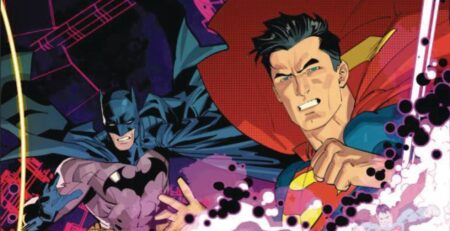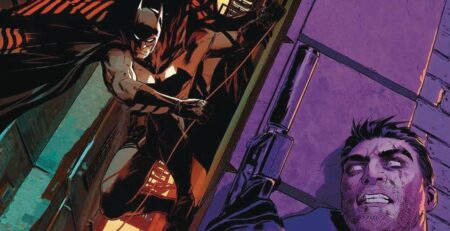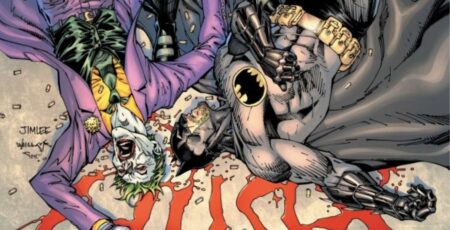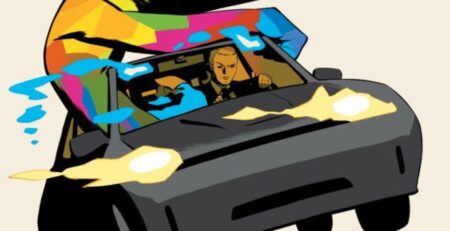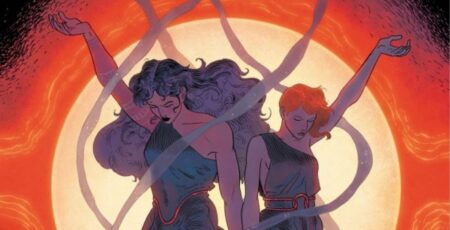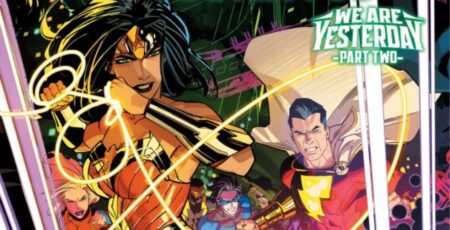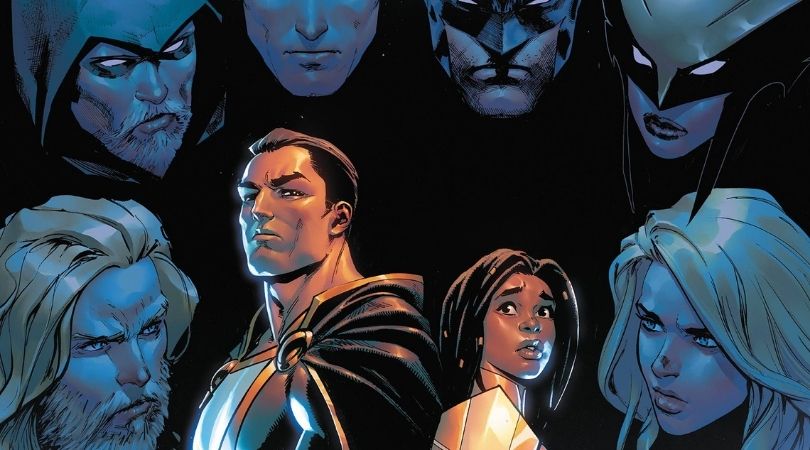
Justice League #63 is published by DC Comics. The main story is written by Brian Michael Bendis and the artist is David Marquez. The colourist is Ivan Plascencia and the letters are by Josh Reed. The second story is written by Ram V with art by Xermanico. The colourist is Romulo Fajardo Jr. and the letters are by Rob Leigh.
In the Justice League story, the team has traveled to the homeworld of new hero Naomi, in search of Brutus. Brutus had started to cross into their world, attacking Black Adam and Hippolyta. Upon arrival, the heroes were separated and found their powers malfunctioning or powered up. The Flash reveals that misjudging the vibrational frequency of the other dimension, it resulted in the change. The League battled their new enemy, ultimately besting him. But they were interrupted by Zumbado, the man responsible for the death of Naomi’s parents and her world.
The plot continues just after the last issue, but there is a small jump forward in time. This is a clever move by Bendis as it eases the reader into Justice League #63 without overwhelming them. Because after that comes another gigantic, enthralling battle, full of powers, personality, and posturing. Batman is missing and Superman is down, weakening the Justice League. Naomi is wanting to destroy Zumbado. The fight is incredible, as is the aftermath. This is the end of the current arc, so the last half of the issue powers down whilst also building up what is yet to come. At times Bendis loses control of the page, with too many panels happening at once, but this only occurs occasionally. The future of the Justice League looks strong, with some new faces added to the mix.
There is a gigantic cast inside this story, but the writer controls them and makes each of them stand out. Naomi is the central figure of this issue, with her anxiety and panic attacks a key point within the comic. The reaction from the rest of the team humanises them and may instill strength in some members of the audience.
The characters interacting with each other is superb for the majority of the time. Bendis has captured the voices of each member terrifically, as well as the overall chemistry within the team. But as previously mentioned, it can spiral out of control in some of the large panels and pages. There are too many people talking over each other., with multiple conversations happening at the same time, and it can be incredibly disorienting.
Marquez maintains the high-octane energy from the previous issue, the battle expertly choreographed. For the artist to manoeuvre this many participants in the fight and create stunning artwork is admirable. Each character looks extremely powerful, and the boosted powers look incredibly when demonstrated. Marquez also presents amazing facial expressions, with the very precise feelings that Naomi is feeling presented well by their line art. The one negative of the artist is the same for the writer; there is one sequence of panels that is immensely difficult to follow due to the sheer amount of panels.
The colours by Plascencia are crisp and well-suited for the story. The colourist is very influential in making sure the powers are easily identified and that they aren’t too overpowering for the reader. There are some gorgeous shades included, for example, the gold on Hawkgirl’s costume, or the waves emanating from Black Canary’s ear-shattering scream. The lettering by Reed is effective, but the placement of the panels could do with improvements. Whilst the large amount of dialogue provided by Bendis can be difficult to place, their location on the page has a huge impact on how it is read.
In the second story, the Justice League Dark are hunting Merlin, the greatest sorcerer in creation. Tracking him through time, Constantine and Zatanna have picked up Etrigan, Ragman and Detective Chimp. They continue their mission in this issue, as their nemesis seeks to turn fiction into reality. Inside a massive library, the heroes seek to do the opposite, finding Ram V’s Justice League Dark author note. And elsewhere, more mystical heroes are at work.
This story continues to be entertaining, with metaphysical elements of the plot returning. These world-bending elements to the story match is both fun for the reader and fit with the rules that Merlin was breaking himself, tampering with fiction and reality. As they continue their mission the team finally leaves the library. Whilst there was nothing inherently wrong with this setting, the limited time given to this story within this comic means that a lot of time has been spent inside the library, and a new location is refreshing. The most frustrating aspect of the second story inside Justice League #63 is that it isn’t long enough. This chapter is split into three settings all with fascinating dynamics. But there are only 8 pages for this to be told across. The characters are great, but it is very difficult to get a grasp on the plot or any form of momentum when the story stops as quickly as it starts.
Xermanico’s art is incredible. Each character is presented beautifully, with intricate details spun into the magic they cast. There is a return to more gothic architecture towards the end of the tale, which is a perfect match with the artist’s style. The line art used for these locations results in jaw-dropping imagery.
The style of the art changes briefly like it did in the first issue of Xermanico and Fajardo’s involvement in the run. In one page, depicting an ancient tower, it seems as if it has been created through pastels or even paint, massively different to the panels inside buildings. This may be both the artist and colourist, but the alteration is striking and stunning. The shades and lighting that Fajardo adorns the rest of the panels with are as superb as the rest of the panels.
The lettering is comfortable to read and dynamic, with some new techniques used by Leigh at the end of the issue. Certain words have the impression of being scribbled over, so the figure listening and the reader can’t hear. This is both effective and works well towards trying to convey voices to the reader.
Justice League #63 again features two stellar stories by talented creators. The mind team tale is action-packed and expertly illustrated, wrapping up an exciting first arc for Bendis and Marquez. However, it loses track of itself for brief moments of the comic. In contrast, the backup story is struggling to implement drama because of how restrictive its space is within the book. If the comic was bumper-sized or there was a fairer split between the stories, it may be more beneficial. Because as it stands, they are harming each other.
Justice League #63 is where comics are sold.
Justice League #63
TL;DR
Justice League #63 again features two stellar stories by talented creators. The mind team tale is action-packed and expertly illustrated, wrapping up an exciting first arc for Bendis and Marquez. However, it loses track of itself for brief moments of the comic. In contrast, the backup story is struggling to implement drama because of how restrictive its space is within the book. If the comic was bumper-sized or there was a fairer split between the stories, it may be more beneficial. Because as it stands, they are harming each other.

